Allergic Rhinitis
Allergic Rhinitis : Definition
Western Medicine
Allergic rhinitis is a condition that presents frequent attacks of sneezing, nasal discharge or blockage of the nasal passages. It may be seasonal (a limited period of the year) or perennial (throughout the whole year).
Seasonal rhinitis is often called "hay fever" and is the most common of all allergic diseases, about 2 to 20 per cent of the population worldwide are thought to be affected. Teenagers experience the highest prevalence, with up to 30% of young people showing symptoms during the summer months.
Chinese Medicine
Traditional Chinese Medicine (TCM) has a long history of managing hay fever, with symptoms documented as early as 2000 years ago. The Yellow Emperor’s Classic of Internal Medicine provides detailed descriptions of symptoms like nasal congestion, nasal itchiness, sneezing, and clear nasal discharges, which align closely with modern understandings of hay fever.
The nose is responsible for breathing, smelling, and aiding pronunciation. From a TCM perspective, nasal functioning closely relies on the support and regulation of internal organs and meridians. TCM regards the nose as an orifice of the lungs on the body surface, the external portal for gas exchange. When lung qi is abundant, the nasal passages remain clear, with a keen sense of smell and smooth breathing. Conversely, lung disharmony can lead to nasal congestion, a runny nose, or a decreased sense of smell. Therefore, TCM treatments often aim to regulate and strengthen lung functioning to improve nasal health.
The spleen is responsible for nutrient essence production, and the kidneys are responsible for essence storage of the body; both organs are critical for proper nasal functioning too.
Beside the Lung meridian, the Governor Vessel meridian runs across the midline of the front head, passing through the nose vertically. The acupoint, ying xiang (LI 20, located at the outer edge of the nostril) is the starting point of the Large Intestine meridian and the endpoint of the Stomach meridian. These meridians are closely associated with acupuncture therapy for nose problems. 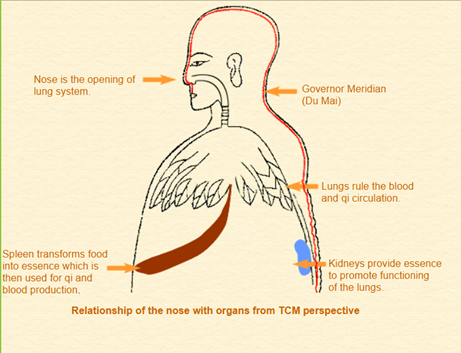
Allergic Rhinitis : Causes
Western Medicine
Allergic rhinitis, also known as hay fever, involves inflammation of the nose, sinuses, and eyes. The allergic reaction occurs when the body’s immune system overreacts to allergens such as pollen, dust mites, mold, or pet dander, that are usually harmless. The immune system mistakenly identifies the harmful antigens, and the response leads to the release of histamines and other chemicals, causing inflammation and allergic symptoms. Doctors usually divide the disorder into two categories: - Seasonal allergic rhinitis
- Perennial allergic rhinitis
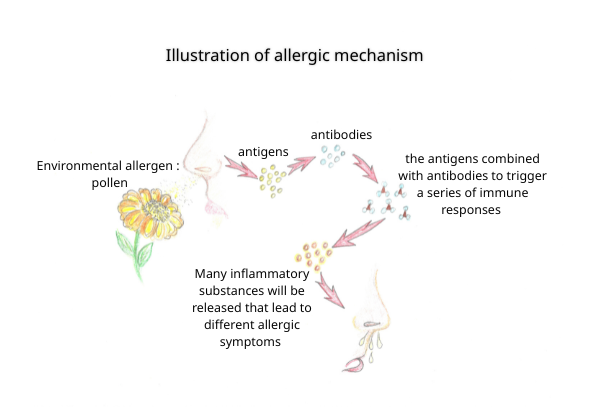
Allergic Mechanism in Western Medicine understanding
Chinese Medicine
TCM claims that the development of allergic rhinitis has internal and external aspects.
(I) Internal deficiency
A deficiency inherited at birth, chronic illness, over-exertion, improper diet, or emotional distress can all damage internal organs. Under-functioning of organs and depletion of blood and qi (vital energy) make the body susceptible to illness. For allergic rhinitis, organs like the lungs, spleen, and kidney are mainly associated with the internal deficiency of the rhinitis.
- Lung deficiency: The nose is considered as the external opening of the lungs, usually known as nasal orifices; a lung deficiency leads to weakened nasal functioning. Lung deficiency also leads to weak protective qi, making the exogenous evils invade the nose orifice more easily. The result will be recurring episodes of nasal problems, such as congestion, watery discharges and sneezing.
- Weak stomach and spleen: The spleen and stomach are responsible for transformation and transportation of nutrient essence for the body. When the functions become weak, there will be a decline in qi and blood internally, and the nose will lose its supply of nutrient. This reflects a disorder in the nasal linings (mucous membranes), leading to nasal obstruction, watery discharge, and sneezing. The sense of smell is also affected too.
- Kidney deficiency: Normally, the kidney assists the lungs in ruling qi movements and body fluid distribution inside the body. Kidney deficiency can distribute qi activities and fluid distribution, and also affect the essence supply to the nose, leading to nose problems such as pale and swollen nasal linings, frequent episodes of nasal itching, sneezing, and watery discharges from nose.
(II) Invasion of exogenous evils (external aspect)
The nose is located at the center of the face, representing the most yang part of the body, and the region receives abundant blood flow. Wind evil is the leading cause of many illnesses, often bringing other exogenous pathogens along and likely attacking the nose. Therefore, nasal symptoms are very common in exogenous diseases.
From a TCM perspective, hay fever is usually resulted from a combination of external pathogens and body weakness. When the body is weak and the protective qi is not strong, exogenous pathogens take advantage of the chance and attack the body. Additionally, the extent of influence from internal and external factors determines the development of hay fever. Their roles vary in each case and even during specific episodes. Generally, new cases or acute attacks are primarily influenced by external factors, while chronic or recurring episodes are mainly influenced by internal factors.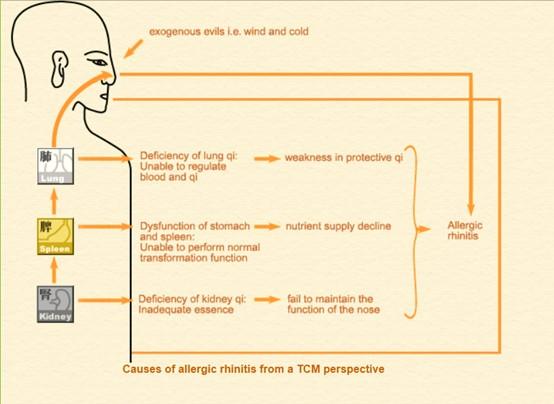
Allergic Rhinitis : Symptoms
Western Medicine
Individuals with this disorder typically experience cold-like symptoms, such as sneezing, watery eyes, nasal congestion, itchy and runny noses, and sometimes headaches or fatigue. Early morning and late evening are the most usual periods to have symptoms. The episodes are characterized by recurring with acute onset, and each time the symptoms can rapidly subside, leaving individuals healthy between episodes.
Seasonal allergic rhinitis has the following features:
- Frequent sudden attacks of sneezing, with profuse watery nasal discharge and nasal obstruction.
- Each time, the attack only lasts for a few hours, and is often accompanied by sharp pain, watery and pink eyes (conjunctivitis).
- Some individuals may have conjunctivitis without nasal symptoms.
- The condition does not cause fever.
- Swelling of the nasal linings may lead to headaches, due to a build-up of pressure in the nasal passages and sinuses.
Since seasonal rhinitis is mild, individuals often don’t seek medical care. However, the disorder can be extremely exhausting for some, with symptoms like persistent sneezing, a constant runny nose, and relentless itching.
Perennial allergic rhinitis
Symptoms are similar but tend to be more continuous and generally less severe. It's not surprising that individuals with multiple clinical sensitivities often experience perennial rhinitis along with one or more predictable seasonal flare-ups, and so vary in severity.
Individuals usually don't cause dramatic symptoms. However, a persistently blocked nose can lead to complications like mouth breathing, snoring, and a dry throat. Dark circles and puffiness can develop under the eyes. Swollen mucous membranes can easily get infected and further cause recurrent or chronic sinusitis. Drainage from nasal infections can lead to a sore throat and bronchitis. In children, when the eustachian tubes are blocked by swollen mucous membranes, enlarged adenoids, or excess discharges, there can be ear problems like temporary deafness and recurrent middle ear infections.
While individuals with allergic rhinitis tend to develop bronchial asthma more frequently than the general population, the exact increase in risk is not well-defined. Generally, the risk of developing asthma increases with the severity of rhinitis, especially if chronic sinusitis and bronchial infections are present, or if the individual has had asthma attacks in the past.
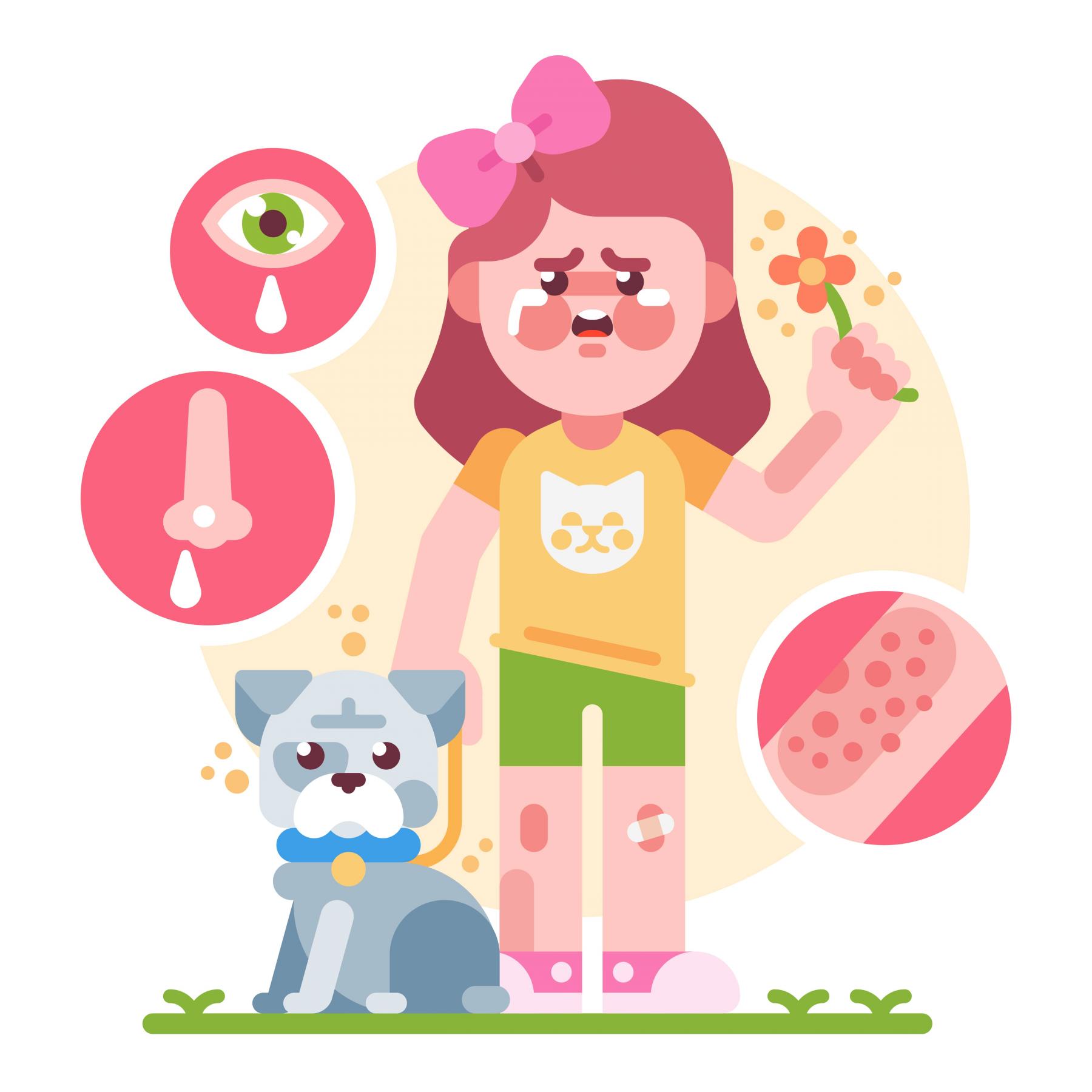
Chinese Medicine
During a consultation, TCM physicians rely on the four examination skills to collect clinical information for diagnosis. The information will be grouped into a syndrome or disharmony pattern and then used for planning treatment. It should be noted that a disharmony pattern only indicates certain pathological stages of a disease, therefore it is necessary to adjust the treatment during disease development. The following are common disharmony patterns for allergic rhinitis:
1.Wind-cold attacking lungs
Nasal itching, sneezing, nasal congestion, and watery discharges, the symptoms are usually triggered by being exposed to windy weather or a cold temperature in the morning. Other accompanied signs include pallor, shortness of breath, ease of sweating on exertion, and aversion to cold.
2.Lung and spleen deficiencies leading to dampness accumulated
Sneezing, watery nasal discharge and moderately severe nasal congestion, other accompanied signs may include heaviness in the forehead or a pounding pain between the eyebrows, a loss of sense of smell, fatigue, shortness of breath, aversion to cold, limb heaviness, abdominal fullness, a poor appetite, and diarrhea.
3.Kidney yang depletion failing to support and warm lungs
Nasal congestion, sneezing with watery discharge, aversion to cold, and cold limbs, the symptoms usually occur after a cold sensation in the shoulders and back. Other accompanied symptoms include dizziness, ear ringing, night frequency, impotence or premature ejaculation, and a hot sensation in the palms and soles of the feet.
4.Spleen deficiency and phlegm obstruction
Severe nasal congestion, copious watery discharge, and nasal itching. On examination, the nasal linings swollen obviously. There may also occur heaviness in the forehead, limb weakness, fullness in the chest and gastric regions, copious white sticky sputum in the throat, poor appetite, and diarrhea.
5.Wind-heat attacking lungs
Frequent sneezing, nasal itching, and severe congestion, the runny nose will be serious when further stimulated by foreign objects or warm temperatures. Individuals often exhibit a pattern of alternating relapse and remission. The other accompanied symptoms include fever, aversion to cold, headache, and sweating.
Allergic Rhinitis : Diagnosis
Western Medicine
The diagnosis of allergic rhinitis is based on the patient's history and physical examination during symptomatic periods. While sneezing attacks, nasal discharge, and blockage are common, they are not unique to this condition, and perennial rhinitis symptoms can resemble those of other disorders too. The key feature of allergic rhinitis is that symptoms appear or worsen predictably in response to specific allergens (e.g., a person develops a runny nose or sneezing when exposed to pollen). Therefore, a careful analysis of factors that trigger rhinitis is crucial for diagnosis.
Individuals with non-allergic "vasomotor" rhinitis can also experience similar nasal stuffiness and significant nasal discharge. Unlike allergic rhinitis, it does not respond to identifiable allergens. Instead, symptoms are triggered by airborne irritants, extreme temperatures and humidity, pregnancy, menstrual cycle stages, or emotional factors, resulting in abnormal regulation of the blood vessels in the nasal lining.
Clinical history
A clinical history of symptoms upon exposure is the most reliable indicator of the causative agents in respiratory allergies.
- Variations in symptoms during and after travel can be very significant.
- It's important to note and record the effects of exposure to house dust mites, animals, fur products, feathers, seed derivatives, silk, and similar allergens.
- When casual observations are insufficient, history can be "created" by significantly increasing or reducing specific exposures, such as foods or house pets, for brief periods to observe the results.
- Additionally, the timing and location of symptom occurrence can provide clues to the cause. Specific pollen sensitivities can be identified if symptoms are precisely dated and the season of local airborne pollen prevalence is known. Similarly, recognizing heavy fungus exposures associated with activities like leaf collection, lawn care, gardening, and hiking in tall vegetation can help explain related symptoms.
Skin testing
- Skin tests that produce a wheal-and-flare reaction are useful and widely performed.
- To test immediate reactivity to an allergen, a "prick test" is done by pricking the skin through drops of a water-extract of the allergen.
- Small quantities of extracts can also be injected into the skin using a needle, but this can be hazardous for highly sensitive individuals, so prick tests are usually done first. Only those with negative reactions to the prick test are considered for the injection test.
Few additional tests are available to evaluate respiratory allergies. Initial hopes that a blood test might aid in diagnosis have not been sustained.
Chinese Medicine
For allergic rhinitis, TCM diagnosis is primarily based on the clinical presentations of paindividuals, concluding the disorder as a disharmony pattern. At various stages of the disease, different disharmony patterns will be present, and so individuals with the same disease will be treated differently, depending on the type of disharmony pattern they have. The procedures used in TCM to differentiate between disharmony patterns of allergic rhinitis can be explained as follows:
1.Wind-cold attacking lungs
Due to constitutional weakness, the individual is susceptible to cold and flu or other illnesses. In terms of TCM, this usually means that the individual does not have strong protective qi and this enables exogenous pathogens such as wind and cold evils to invade the nose easily. On examination, the nasal linings are pale and swollen, and with clear watery discharges. The tongue is pale and covered by white fur, the pulse is weak and fine.
2.Lung and spleen deficiencies leading to dampness accumulated
Under-functioning of lungs and spleen can lead to disturbance of body-fluid metabolism, retained fluids or dampness accumulation will be resulted. When the nasal orifices are affected, the nasal linings appear swollen, pale and producing excessive secretions. On examination, the tongue looks bulky, and pink with teeth marks on the edges; the tongue coating is white and greasy, and the pulse is weak and hesitant.
3.Kidney yang depletion failing to support and warm lungs
In TCM, kidney yang is responsible for warming the entire body and assisting in the functioning of all bodily processes. Depletion of kidney yang usually occurs after long-term illness or severe organ damages, which leads to under-functioning of the organs, interrupted the flowing of qi and blood, and lung functioning and the nose are inevitability being affected. On examination, the tongue is pink red and covered with moist white fur, the pulse is weak and thready.
4.Spleen deficiency and phlegm obstruction
TCM believes that the spleen and stomach are very vulnerable to an improper diet, attack of exogenous pathogens, or the influences of other organ deficiencies. Spleen deficiency leads to a decline in qi and blood production, or nutrient essence production; the consequence is that the body will become malnourished, and phlegm can accumulate easily. When nasal orifices can’t get sufficient nutrient supply, the nasal linings will become disorder. On examination, the tongue is pale and covered by thick white greasy fur, the pulse is slippery.
5.Wind-heat attacking lungs
Nasal symptoms are common when exogenous pathogens like wind and heat fight against the protective qi, which usually presents as part of the lung wei-symptom. On examination, the nasal linings are swollen and red, and with clear watery discharges or sticky thick discharges. The tongue is slightly red and covered with thin fur that may be yellow; the pulse is floating and rapid.
Allergic Rhinitis : Treatment
Western Medicine
Allergic rhinitis treatment consists of environmental measures to avoid allergen exposure, drugs, and desensitization. For any disease with an inherent or hereditary component, prevention by avoidance of allergens is usually the most effective means of treatment. Avoidance is not always possible or practical, however, and so medications are needed to control symptoms. In some cases, the immune response itself can be altered by desensitization therapy.
(I) Environmental measures
Avoidance of allergens should be based on a clinical history of symptomatic allergy, rather than solely on a positive skin test. Appropriate measures for individual cases may include:
- Removing household pets to reduce exposure to pet dander.
- Controlling house dust exposure by frequent cleaning and avoiding dust-collecting toys or objects in the patient's bedroom.
- Using air-cleaning devices with high-efficiency particle filters.
- Dehumidifying and repairing leaking pipes to prevent mold growth.
- Avoiding pollen and outdoor molds by staying indoors during high pollen seasons and using air purifiers.
Avoiding pollen or molds is challenging unless the patient can stay in an air-conditioned home or office. To reduce contact, consider:
- Wearing sunglasses.
- Driving with car windows shut.
- Avoiding walks in the countryside, especially in the late afternoon when pollen levels are highest.
- Keeping bedroom windows shut at night.
These measures alone are often insufficient to control symptoms, so additional drug therapy may be needed. Pollen exposure is generally lower at the seaside, where sea breezes keep pollen grains inland. Planning a holiday to a pollen-free area during peak pollen season can also help.
For occupational allergies, efforts should be made to modify the patient's work routine and employ industrial hygiene measures to avoid allergen exposure. If these measures fail, changing the patient's job may be necessary.
 Avoidance of allergens is an important measure for allergic rhinitis
Avoidance of allergens is an important measure for allergic rhinitis
(II) Drug Treatment
1. Antihistamines
Antihistamines are the most common treatment for rhinitis. They are particularly effective against sneezing but less effective for nasal discharge and have little impact on nasal blockage. Older antihistamines, like chlorpheniramine and promethazine, can cause sedation. Newer antihistamines, such as astemizole, cetirizine, loratadine, and terfenadine, specifically target histamine receptors and do not cross the blood-brain barrier, so they do not cause drowsiness. These drugs are generally equally effective, but the choice may depend on cautions and interactions with other medications. It's important to seek advice on this.
2. Decongestants
Decongestant drugs are widely used to treat nasal obstruction. They can be taken orally or, more commonly, applied directly as nasal drops or sprays. However, prolonged use can lead to rebound congestion, where tissues become resistant to the medication, resulting in worse congestion than before. Local decongestants may be the only effective treatment for vasomotor rhinitis, but they should be used carefully to avoid rebound nasal obstruction. Typically, these preparations are prescribed for a limited period to open the nasal airways for other treatments, especially topical corticosteroids.
3. Anti-inflammatory drugs
Two types of anti-inflammatory drugs are used to treat allergic rhinitis, sodium cromoglycate and nedocromil sodium, as well as corticosteroids.
- Sodium cromoglycate and nedocromil sodium: these drugs block inflammatory mediators. Applied topically as sprays or powders for preventing and treating mild to moderate allergic rhinitis. They are safe for children and effective for managing allergic conjunctivitis.
- Corticosteroids: the most effective treatment for rhinitis involves small doses of topically administered corticosteroids, for example the beclomethasone or fluticasone spray. These doses are insufficient to cause systemic effects and primarily act as anti-inflammatories. They should be started before seasonal symptoms begin and combining a topical corticosteroid with a non-sedative antihistamine taken regularly is particularly effective in preventing symptoms. Nasal corticosteroid sprays are generally safe, though minor burning and nosebleeds can occur. Prolonged use should be monitored periodically. Corticosteroid eye drops should be used sparingly and only for brief periods to control acute severe allergic conjunctivitis, with careful monitoring by an ophthalmologist.
(III) Desensitization
Chinese Medicine
According to TCM understanding, allergens are considered exogenous pathogens that can only attack the body when there is a deficiency in healthy energy (low disease resistance) or an imbalance in yin and yang. The saying "When healthy energy is present, pathogens cannot invade" reflects this principle.
TCM methods can benefit allergic rhinitis, especially for those with recurrent episodes, limited effectiveness from Western medicine, or those seeking overall health improvement. It can be achieved through methods such as expelling pathogens, alleviating symptoms, strengthening the lungs, tonifying the spleen, and warming the kidney, TCM provides comprehensive treatment. The long-term results are favorable, with reduced recurrence and alleviation of symptoms.
 |
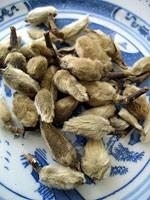 |
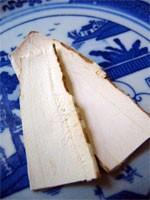 |
| astragalus root | biond Magnolia flower | Dahurian angelica root |
(I) Herbal Prescriptions for Allergic Rhinitis
1.Wind-cold attacking lungs
Therapeutic aim: warm the lungs, consolidate the superficial body, eliminate the wind and unblock the nasal orifices.
Sample prescription:
astragalus root (huang qi)
2.Lung and spleen deficiencies leading to dampness accumulated
(II) External Therapy for Hay Fever
The herbal remedies are used to clear nasal passages and alleviate symptoms like congestion and inflammation.
Ingredients:
small centipeda herb (e bu shi cao)
Ingredients:
yellow croaker earstone (yu nao shi)
The above ingredients are ground into fine powder and then add proper amount of Vaseline to prepare into a paste form, which is used to wipe in the nasal passages.
(III) Acupuncture Therapy for Hay Fever
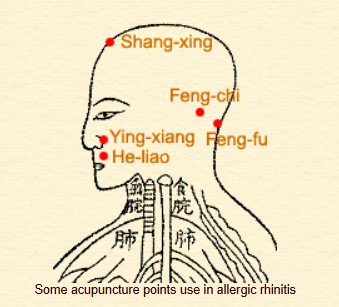
(IV) Massage Therapy for Hay Fever
Allergic Rhinitis : Prevention
Western Medicine
Allergic rhinitis has no cure, it can significantly impact on sleep, concentration, working or studying, and even daily function of the individuals. Effective management is essential to reduce the symptoms and improve their quality of life. Individuals with seasonal allergic rhinitis should make efforts to avoid pollen exposure. This can be achieved by avoiding rural areas and staying indoors with windows closed during high pollen seasons. Preventing perennial rhinitis involves avoiding identifiable causative factors as much as possible.
If you are allergic, try to avoid common allergens such as: pollen, dust mites, pet dander, mold and certain foods.
| dust mite | sea food | pet dander | pollen |
Chinese Medicine
The way you live, and your daily habits are critical for managing allergic rhinitis or hay fever. A multifaceted approach can reduce exposure to allergens and alleviate symptoms effectively. TCM recommends the following strategies:
Managing environmental factors
- Pay attention to the impact of climatic changes, avoid entering or exiting environments with extreme temperature differences, especially during autumn and winter when temperature fluctuations are great. It's important to add layers of clothing in time to avoid catching a cold and prevent external pathogens from causing illness.
- Try your best to avoid common allergens such as pollen, mites, feathers, fibers, insects, paint or irritating odors.
- Keep the living space clean, regularly air out bedding, reduce indoor dust, and move to a sunny and dry living area. For those who have a high opportunity to contact with allergens, it's advisable to change their work environment as much as possible.
| Clean and warm environment | Moderate and regular exercise |
Keeping fit
Moderate and regular exercise will help strengthen the body's resistance and reduced recurrence.
Dietary management
From a TCM perspective, foods and herbs come from the same source, so foods can have similar properties and functions to those of herbs. The properties of food refer to cold, hot, warm and cool; the five flavors of food include pungent (acrid), sweet, sour, bitter, and salty.
- During the attacks of allergic rhinitis, certain foods are recommended to eat more. These include foods that are acrid tasting, foods that promote warmth and sweating, and foods that facilitate the lung's dissemination functions. These foods also help to eliminate exogenous pathogens. Such foods include spring onions, ginger, or fresh coriander.
- In general, individuals should avoid excessive consumption of cold, greasy, and spicy foods. Seafood and other foods known to trigger the disorder should likewise be avoided.
- Foods that tonify are always beneficial for hay fever individuals, such as Chinese date, walnut, Chinese yam, Shiitake mushrooms and lamb should be eaten more frequently. These foods help invigorate qi (vital energy), tonify the spleen, and build up the body's resistance.
Dried mushroom and walnut help to invigorate qi and buildup resistance:
Spring onions and ginger help to eliminate the exogenous evils:
Avoid known foods that trigger the disorder such as shrimp:
Allergic Rhinitis : References
Western Medicine
- Chapel HM, Haeney MR, Misbath A, et al. Essentials of Clinical Immunology, 4th ed. Oxford: Blackwell Science, 1999: 224-5.
- Crompton GK, Haslett C. Diseases of the respiratory system. In: Edwards CRW, Boucher IAD, Haslett C, et al, eds. Davidson's Principles and Practice of Medicine, 17th ed. Edinburgh: Churchill Livingstone, 1995:393.
- Rusznak C, Davies RJ. ABC of allergies. British Medical Journal 1998;316:686-9.
Chinese Medicine
- Chen Guo-feng, ed, Gan's E.N.T. & Stomatology, Jiang Su Science and Technology Publishing Co Ltd, 1999:183.
- Wang min-yu. 315 allergic rhinitis clinical cases treated by infusion for evacuating wind evils and promoting blood circulation. Zhejiang Chinese Medicine Journal 1992;27(7):310.
- Wu Cheng-shan. Exploring allergic rhinitis in treating phlegm and dampness evils. Shan Xi Chinese Medicine 1996;17(12):544-5.
- Zhang En-qin. Clinical Medicines of Traditional Chinese Medicine. Publishing House of Shanghai College of TCM, 1990:7.
Written and Edited By:
Western Medicine
Dr Lily Holman MB MSc PhD
Senior Lecturer, Middlesex University, London, UK.
Chinese Medicine
Dang Yi (黨毅) MD PhD
Professor, Beijing University of Chinese Medicine; Visiting Professor, Middlesex University,
London, UK; Vice Director, Gourmet Food Institute of Health Care and Nutrition of Beijing, PRC.
Translations
Rose Tse, Integrated Chinese Medicine Holdings Ltd.
Editors
Angela Collingwood, MSN Integrated Chinese Medicine Holdings Ltd.
Carol Dyer, BPharm, MRPharms, Integrated Chinese Medicine Holdings Ltd.
Rose Tse, Integrated Chinese Medicine Holdings Ltd.


